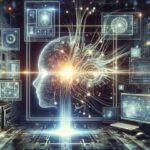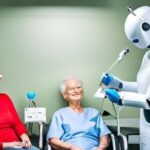How AI Algorithms Work: Step-by-Step Guide for Beginners
How AI Algorithms Work: Complete Explanation for Beginners
Have you ever been curious about how your phone unlocks by simply gazing at your face, or how Netflix seems to predict what show you’ll want to watch next? These aren’t just fancy features—these are driven by something called AI algorithms.
Now, don’t panic if you think the word “algorithm” is too technical-sounding. Throughout this blog, I will explain it all in simple English, dismantling it all in plain terms so that it makes sense—even if you know absolutely nothing about technology.
So, let’s get started.
What Exactly Is an AI Algorithm?
At its most basic, an algorithm is simply a list of directions. Like a recipe to bake a cake. You do steps in a certain sequence to produce a tasty outcome.
Now think of an AI algorithm as an extremely intelligent recipe. But rather than baking a cake, it’s making decisions—such as recognizing your voice, seeing images, translating language, or suggesting songs.
AI programs are programmed to learn from data. The more they “observe,” the more intelligent they get. It’s somewhat similar to how we learn: we observe patterns, we memorize, and we make better decisions the next time.
Let’s Begin with the Fundamentals: How Does AI Learn?
To get a sense of how AI operates, imagine teaching a child to identify a dog.
You present them with 100 pictures: “This is a dog. That’s a dog too.” Gradually, the child will begin to see patterns—the hair, the shape, the nose—and after time, they will know what a dog is even if they encounter a new one they have never seen before.
That is how AI operates. In place of a child, we have a computer. In place of pictures, we have information. And in place of merely observing, the computer applies an algorithm to observe, learn, and get better.
Types of AI Algorithms (Explained Simply)
There are various types of AI algorithms, depending on what we wish the AI to learn. Let me break down the three major types simply:
- Supervised Learning – “Learning with guidance”
This is similar to having a teacher. You provide the AI with input (such as an image) and the proper output (such as “this is a cat”). The AI learns from these examples and applies what it knows to new information.
Example: Spam filtering in email. You teach it what spam and what’s not spam. It learns over time what spam tends to look like and automatically filters it out.
- Unsupervised Learning – “Learning without a teacher”
In this case, the AI doesn’t receive the answers. It must determine things on its own.
Example: Suppose you feed the AI hundreds of shopping receipts. You don’t give it any information about them, but it begins to cluster similar receipts together—i.e., looking for patterns in customers’ buying habits. That’s unsupervised learning.
- Reinforcement Learning – “Learning through trial and error”
Conceptualize this as training a dog to sit. If it sits right, it receives a treat. If not, no treat. After many repetitions, it figures out what actions produce rewards.
Example: Driverless vehicles. They experiment with various methods of navigating and figure out which ones prevent them from colliding with things, obey traffic regulations, and ensure passengers’ safety.
⚙️ Step-by-Step How AI Algorithms Function
Let’s divide it into an everyday, tangible process:
- Gather Data
As we require ingredients to prepare food, AI requires data to operate. It can be anything—images, words, sound, video, or digits.
For instance, to train an AI to identify cats, we require thousands of cat images.
- Clean the Data
Raw data is dirty. We have to make it tidy. This process entails eliminating mistakes, filling in blanks, and arranging it in the right way. - Select the Correct Algorithm
Depending on the issue, the right algorithm is picked. Want to forecast something? Classify pictures? Discover patterns? There’s an algorithm for that. - Train the AI
This is where the magic occurs. The algorithm is provided with data and begins to recognize patterns, refining itself in the process.
Consider training a child by exposing them to pictures of apples and oranges on a daily basis. They learn the difference eventually. That’s training.
- Test the AI
We test it once it is trained using new data that it has not encountered previously to determine how well it fares.
It’s as if administering a test to a student after weeks of class.
- Apply the AI in Real Life
Now the model is ready! The AI can recognize faces, recommend your next playlist, or assist doctors in disease detection.
Daily Examples of AI Algorithms
Still not convinced? You already interact with AI daily, and most times, you don’t even know. Here’s how:
Social Media: Instagram displays posts that you would probably love, depending on your previous behavior.
Maps and Navigation: Google Maps employs AI to provide you with the shortest route by real-time analysis of traffic.
Online Shopping: Amazon suggests items according to your browsing and buying history.
Voice Assistants: Siri or Alexa recognize your voice and answer with useful information—all courtesy of AI algorithms.
Why AI Algorithms Matter
AI is no buzzword—it’s a tool that’s transforming the way we live, work, and communicate. Here’s why it matters:
Efficiency: AI can process huge amounts of data in seconds.
Accuracy: It eliminates human error and enhances decision-making.
Scalability: After training, it can be repeated used without getting tired or bored.
Final Thoughts for Beginners
If you’re new to AI, the world of algorithms might seem a bit complex at first—but it doesn’t have to be. At the heart of it all, AI algorithms are just smart instructions that help machines learn from data and make decisions.
Get the basics down first. You’re interested, you’re looking to launch a tech career, or you just want to know what keeps your favorite apps from crashing—this stuff’s a good starting point.
Some important details about AI:
It doesn’t replace humans—it amplifies what we can do.
We design the algorithms. We teach the machines. And the better we get to know them, the more capable our tools become



